#Marianne North Gallery
Text
So apparently today is also #WorldStickInsectDay? ¯\_(ツ)_/¯

Marianne North (British, 1830-90)
Leaf-Insects and Stick-Insects, Java, c.1876
oil on board, H 35.5 x W 24.4 cm
Kew Gardens Marianne North Gallery MN676
#animals in art#animal holiday#european art#19th century art#Marianne North#natural history art#painting#oil painting#women artists#women in science#British art#insect#insects#Phasmatodea#Kew Gardens#World Stick Insect Day
102 notes
·
View notes
Text

Nepalese Temple and Peepul Tree with Blue Pigeons Bathing, Benares, India
Marianne North (1830–1890)
Marianne North Gallery
53 notes
·
View notes
Text
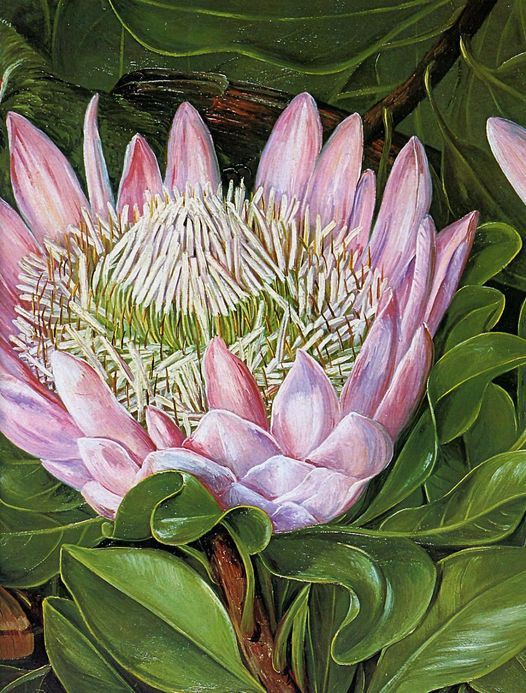
Untitled by Marianne North.
Marianne North (1830 – 1890) was a prolific English Victorian biologist and botanical artist, notable for her plant and landscape paintings, her extensive foreign travels, her writings, her plant discoveries and the creation of her gallery at the Royal Botanic Gardens, Kew.
22 notes
·
View notes
Photo



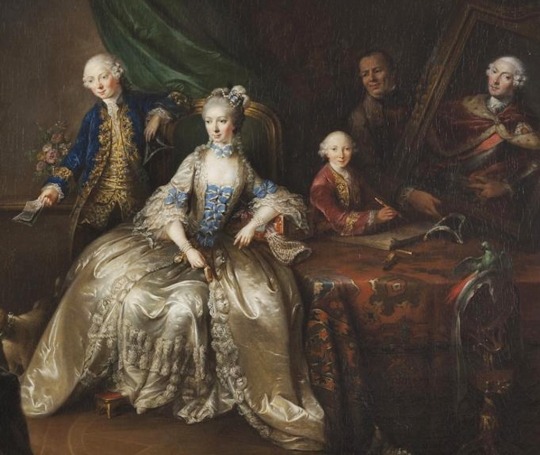


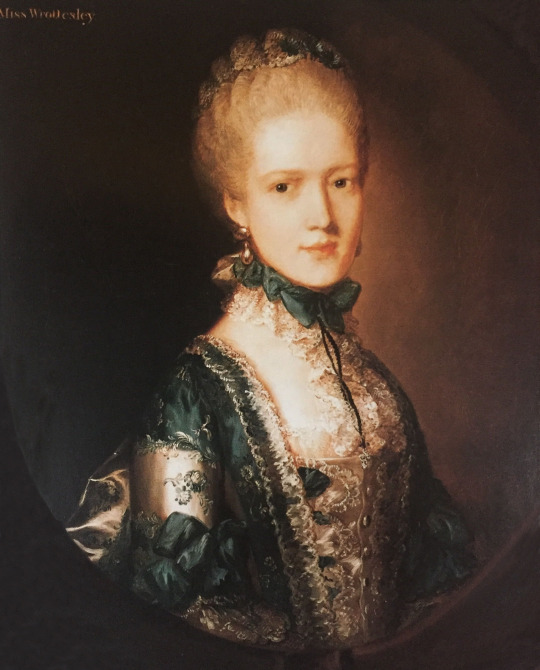
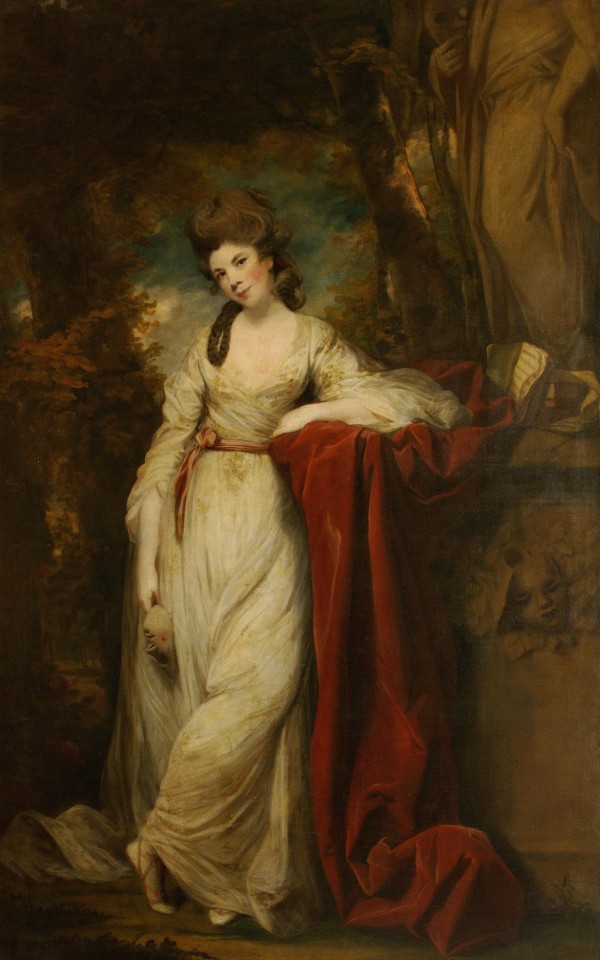
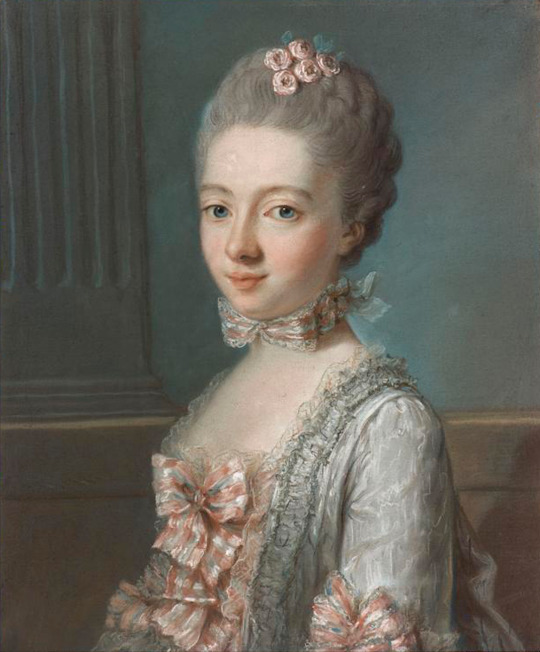
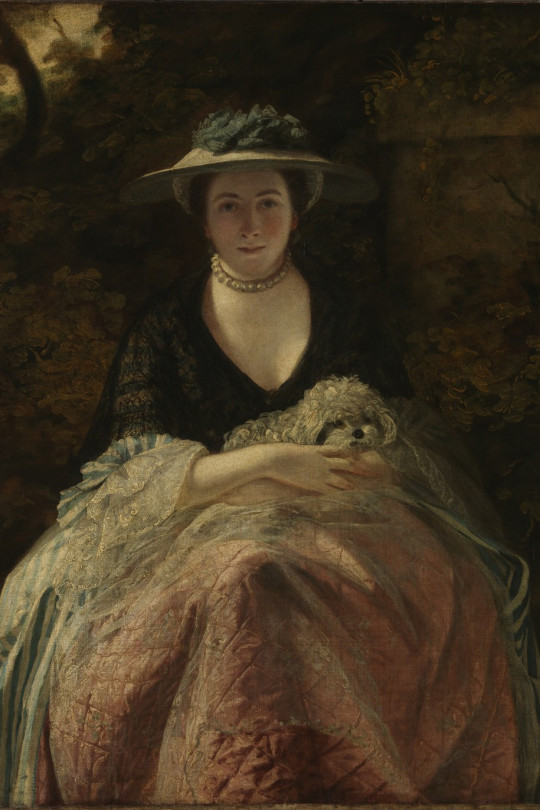
1764 Fashion -
Top: 1764 Infanta Maria Luisa by Anton Rafael Mengs (Kunsthistorisches Museum - Wien, Austria). From Animus Mirabilis' photostream on flickr; erased spots w Pshop 1146X1474 @72 585kj.
Second row left: 1764 Mary Anne Colmore by Francis Cotes (Worthing Museum and Art Gallery - Worthing, West Sussex. UK). From artuk.org 1496X1898 @72 4.1Mp.
Second row right: 1764 Lady Amelia Darcy, 9th Baroness Conyers by François Hubert Drouais (Bowes Museum - Durham, North East England, UK). From Wikimedia 1579X1899 @72 893kj.
Third row: 1764 Marianne Camasse, Countess of Forbach, morganatic wife of Christian IV by Johann Christian Mannlich (private collection). From Wikimedia; enlarged by half 1022X861 @96 235kj.
Fourth row: 1764 Mary, Countess of Howe by Thomas Gainsborough (Kenwood House - Hampstead, London, UK). From mfah.org/blogs/inside-mfah/characters-kenwood-mary-countess-howe 951X1350 @96 262kj
Fifth row left: 1764-1765 Elizabeth Wrottesley, later Duchess of Grafton by Thomas Gainsborough (National Gallery of Victoria - Melbourne, Victoria, Australia) Google Art Project via Wikimedia; blurred bacgrounf to erase cracks 3930X5152 @38 6.8Mj.
Fifth row right: 1764 Mary Wrottesley by Thomas Gainsborough (location ?). From pinterest.at/heritagerose/painting/; fixed lower left corner area and halfway up left side with Photoshop to remove a veiling reflection 2151X2669 @72 1.3Mj.
Sixth row: 1764 Mrs Abington as The Comic Muse, by Sir Joshua Reynolds (Waddesdon Manor - Waddesdon, Buckinghamshire, UK). From Wikimedia 2217X3537 @300 1.3Mj.
Seventh row left: 1764 Madame Lalive de Jully by Joseph Ducreux (Musée Antoine Lécuyer - Saint-Quentin, Aisne, Hauts-de-France, France) photo - Mathieu Rabeau. From Réunion des Musées nationaux Web site; enlarged to fit screen 2380X2872 @144 7.1Mp.
Seventh row right: 1762-1764 (between) Miss Nelly O'Brien by Sir Joshua Reynolds (Wallace Collection - London, UK). From wsimag.com/wallace-collection/artworks/58035 915X1173 @300 427kj.
#1764 fashion#Rococo fashion#Louis XV fashion#Georgian fashion#Infanta Maria Luisa#Anton Rafael Mengs#Mary Anne Colmore#Francis Cotes#Amelia Darcy#François-Hubert Drouais#Marianne Camasse#Johann Christian Mannlich#Mary - Countess of Howe#Thomas Gainsborough#Elizabeth Wrottesley#Mary Wrottesley#Mrs Abington#Joshua Reynolds#Madame Lalive de Jully#Joseph Ducreux#nelly o'brien
21 notes
·
View notes
Video
New York’s hottest museum is…well, we’re biased. 🤭
In 2023, this cultural hub has everything: contemporary artists reflecting on the complex and continuing legacy of the Great Migration; a landmark exhibition celebrating the creativity, ingenuity, and global impact of contemporary African fashions; a multidecade survey of visually captivating, experimental work by María Magdalena Campos-Pons; and the first major exhibition of zines by artists working in North America, bringing attention to this unexamined but vibrant aesthetic practice.
Not to mention bold, new displays of artwork and objects from our collection.
📷 Allison Janae Hamilton (born Lexington, Kentucky, 1984; based in New York, New York). Still from A House Called Florida, 2022. Three-channel film installation (color, sound): 34 min., 46 sec. Courtesy of the artist and Marianne Boesky Gallery, New York and Aspen → Models holding hands, Lagos, Nigeria, 2019. Courtesy Lagos Fashion Week. (Photo: Stephen Tayo) → María Magdalena Campos-Pons (born Matanzas, Cuba, 1959). Red Composition (detail), from the series Los Caminos (The Path), 1997. Triptych of Polaroid Polacolor Pro photographs, framed. Collection of Wendi Norris. (Photo: courtesy of the artist and Gallery Wendi Norris) → Mark Morrisroe (American, 1959–1989) and Lynelle White. Dirt [Fifth Issue], 1975/76. Xerox. © The Estate of Mark Morrisroe (EMM)
#Brooklyn Museum#brooklyn#museum#New York City#nyc#exhibition#art#photography#film#fashion#AfricaFashionBkM#GreatMigrationBkM#Maria Magdalena Campos Pons#zine#zines#things to do#things to see
12 notes
·
View notes
Photo

“Blue Lily And A Large Butterfly”, circa 1882, by Marianne North.
~ Marianne North was a prolific English Victorian biologist and botanical artist, notable for her plant and landscape paintings, her extensive foreign travels, her writings, her plant discoveries and the creation of her gallery at the Royal Botanic Gardens, Kew. Marianne North was born on 24 October 1830 in Hastings, the eldest daughter of a prosperous land-owning family descended from the Hon. Roger North, younger son of Dudley North, 4th Baron North. Her father was Frederick North, a Norfolk Deputy Lieutenant and Justice of the Peace, and Liberal M.P. for Hastings. Her mother, Janet, was the daughter of Sir John Marjoribanks M.P., 1st Baronet of Lees in the County of Berwick. She trained as a vocalist under Charlotte Helen Sainton-Dolby, but her voice failed, and she then devoted herself to painting flowers. After the death of her mother in 1855, she constantly travelled with her father, who was then member of parliament for Hastings; and on his death in 1869 she decided to pursue her early ambition of painting the flora of distant countries. Marianne North travelled with her father in Syria and along the Nile in 1865-67. After her father's death in 1869 she travelled and made paintings in Sicily. In 1871–1872, she travelled to Canada, the United States and Jamaica, and spent a year in Brazil, where she did much of her work at a hut in the depths of a forest. In 1875, after a few months in Tenerife, she began a journey round the world, and for two years painted the flora of California, Japan, Borneo, Java and Ceylon. She spent all of 1878 in various parts of India. On her return to Britain she exhibited a number of her drawings in London. She offered to give the collection to the Royal Botanic Gardens at Kew, and to erect a gallery to house them. This offer was accepted, and the new buildings, designed by James Fergusson, were begun that year. At Charles Darwin's suggestion she went to Australia in 1880, and for a year painted there and in New Zealand. On her return, she presented Darwin the shrub 'Australian Sheep' (Raoulia eximia) as a gift and showed him her Australian pictures. Her paintings of Banksia attenuata, B. grandis and B. robur were highly regarded. Her gallery at Kew was opened in 1882.In 1883, after a visit by her to South Africa, during which trip she called on the botanical artist Katharine Saunders, an additional room was opened at the Kew gallery, and in 1884–1885 she worked in the Seychelles and in Chile. She died at Alderley, Gloucestershire on 30 August 1890 and is buried in the local churchyard. The scientific accuracy with which she documented plant life in all parts of the world, before photography became a practical option, gives her work a permanent value. A number of plant species are named in her honour, including Areca northiana, Crinum northianum, Kniphofia northiana, Nepenthes northiana, and the genus name Northia. Kew Gardens claims that the North Gallery (situated in the east section of the gardens) is "the only permanent solo exhibition by a female artist in Britain". In 2008 Kew obtained a substantial grant from the National Lottery, which enabled it to mount a major restoration of both the gallery and the paintings inside. ~
Source: Wikipedia.
4 notes
·
View notes
Note
Im watching a documentary about celts and white people and white power and Europe and Finnic people and Scandinavian people and The Roman Empire and white people feeling real nazistic now anyway sends all the emojis of the emoji game -🎀
Sana Tamaan Ka Ng Kidlat Ni Bathala
haha anyway wow 🎀 anon that sounds like a very educational documentary. did that inspire uu with any nazi feelings?
『 💉 』
a kin memory
as sunny omori, i was genderfluid afab, probably on the aroace spectrum, and used any pronouns. mari's full name was Marianne. can't remember my first name, i just know that sunny was a nickname that literally everyone used so it became a substitute for my actual name
mari and i were filipino-chinese (+american), kel and hero were south american, Aubrey was filipino-american, basil was just north american. faraway town had a lot of poc
『 🎀 』
a name/prn/title/label i hoard

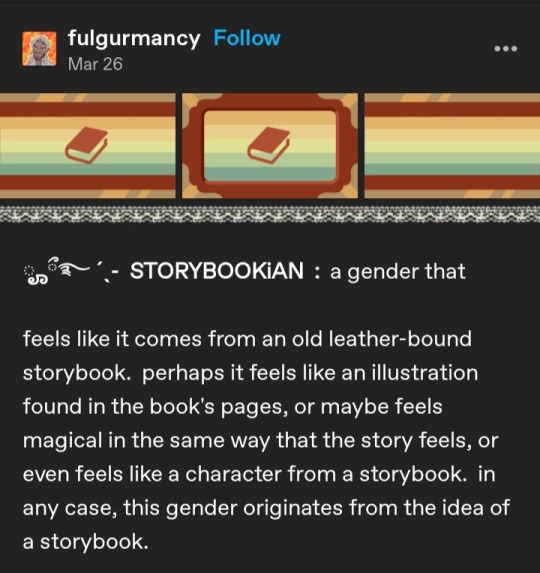
I'm super drawn to anything related to stories :P
『 💊 』
5 min edit of a random character

yk uur talented when uur 5 minute edits still look good as hell /J
i love the "unmotivated" frame sm i wanna use it in an actual edit someday....
"angel stop editing NSO" NO!!
『 💌 』
a quote/song lyric
" i have nothing to complain about. i may not be perfect to you, but I'm plenty good enough to myself. "
" ... now i understand. i wanted everyone to love me. i sought for so much. to know everything when i had everything. but i never tried to find out what i truly wanted... and i can't have it anymore. ah, i could have turned back any time, but now it's all gone because of me ! "
dialogue from the houseki no kuni/land of the lustrous manga. can't remember which chapter but it's near the end. i won't talk about the context much in case i spoil someone but i really really really truly super duper resonate with this dialogue 🙃🙃
『 🫀 』
a game i played
today's game is... va-11 hall-a: cyberpunk bartender action! also known as waifu bartending and the true lesbian experience

time to mix drinks and change lives.
i first learned about it when my friend told me it was the type of game i would like. i looked it up and, wow he wasn't wrong. it really did look like something I'd be into. so when the steam spring sale rolled around a few days or a week ago i bought it!
honestly the title is very direct with what the game is about. you play as Jill, a bartender in va-11 hall-a (referred to simply as Valhalla) in a technologically advanced world and a corrupt city. you serve drinks to your clients, have long conversations with them where stuff about the characters and world is revealed, and tolerate their weirdness. the game is visual novel heavy and focuses a lot on the talking, which is fine with me! i like the combination of lots and lots of dialogue and casual gameplay where uu still kind of need to use uur brain


there's a lot of cute girls in the game (re: waifu bartending and the true lesbian experience)
to the left is Dorothy, a lilim robot (basically an advancedsex robot. her product line in particular is modeled to be on the younger side physically) she's really sweet and bubbly and she has a kind personality. to the right is Dana, Jill's boss. i don't know much about Dana yet but a lot of mystery surrounds her. a lot of characters say she's very strong and there's lots of rumors about how she got her prosthetic arm (a lot of rumors may have been started by her.) also Jill's wallpaper is of herself and Dana together and she apparently has lots of photos of Dana in her gallery. i hope i can see them get together


i find the GUI very satisfying. there's also a home segment where uu sit at home with Jill's cat, fore, and browse Jill's phone. uu can also buy stuff. Jill gets distracted very easily so sometimes uu have to buy things from the online store so Jill would be less distracted at work (SO REAL she's the most accurate representation of ADHD lesbians ever)
since it takes place in a cyberpunk setting there's some political shit going on, the city they live in is a really Bad city with lots of crime and injustice, and the organization "white knights" (basically the cops but stronger and more organized) are known to be power hungry and use their power unfairly for the wrong reasons. also the prime minister seems a bit incompetent? there's also something about a hacker called Alice rabbit... but also at the start of the game, Jill had this weird dream about a girl and occasionally the girl appears on the bar's tv for a split second...... yeah there's a lot going on here
anyways i find the game really fun and i hope to play it more when i have more free time! im still super early in the game . i don't have a singular favorite character yet bc I'm still at the beginning so idk much about them yet and they all look cool to me!!
『 🪽 』
infodump about an oc
OKAY, SO! the oc i will discuss here is connected to nyxa, an oc i discussed here but reading that infodump isn't necessary to understand this one (not like anyone reads these anyway /lh)
remmeber when i said that, as far as nyxa knows she's the only surviving member of her family after they all killed each other?? WELL! that's wrong she's not the only survivor. her older sister survived as well!
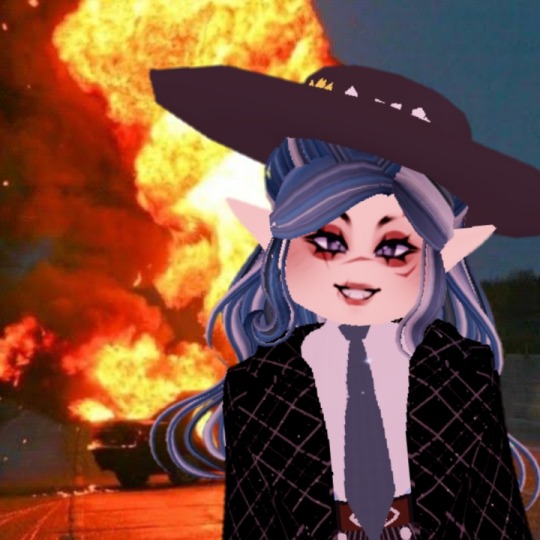

this is Amos faust! (or fraust... i spelled her last name differently sometimes) although Amos isn't really her real name, it's just an alias that she always goes by. shes the head of a detective agency! (in my phoebe and nyxa infodump i mention that nyxa becomes a head of a detective agency when she's an adult. she takes over amos' agency)
her backstory is she studied in cloud tower but in her 3rd year she dropped out and disappeared. no one came looking for her because.. no one really knew her, yk? she was quiet, mysterious, she avoided everyone and everyone avoided her. eventually after leaving cloud tower she began a personal investigation where she hunted down a specific person/group that had something to do with her family's demise (like an enemy of the family) and it led her to a detective agency. she concluded that her target was the director. so she entered the agency, climbed the ranks,became trusted and known within the agency, until she had the opportunity to get close enough to the director and kill them. except, she was wrong about her target, so now she had the blood of an innocent person on her hands. out of genuine guilt and regret (and also because she was emotionally attached to this agency and she figured she would have an easier time continuing her investigation within the agency) she pulled some strings and appointed herself as the new director. and she has been the director for the past ██ years.
Amos is a very eccentric person, and those who don't know her well might even regard her as scary. she arrives to strange conclusions, she comes up with strange plans, but somehow her plans always work. most of the time. the people working under her have learned not to question it. she's very skilled at fighting, spywork, reading and using people, etc. it's hard to know if any of her current personality is even true. but sometimes, one can observe that she genuinely cares for the few people who are very close to her, such as her sister nyxa and her assistant. shes also sarcastic, unafraid to speak her mind, really confident in herself and her abilities.
so how do Amos and nyxa meet again?
basically in their 3rd year at alfea, students can sign up as for different part time jobs with agencies that alfea partnered with. there's a wide range of jobs and it's meant to help the students get familiar with the work environment of the career they want to pursue in the future. yk, gain some experience, make connections, get a paycheck, etc. phoebe and nyxa try applying for many jobs but in the end they go with a detective agency. very few students applied for it so they easily get hired after they attend the orientation and pass the test, and also they think it's really cool
when they applied and worked there for a few weeks/months, the director was away on a long business trip so nyxa didn't immediately realize that her fucking sister was in the agency. and idk if she would realize it immediately either. because she hasn't seen her sister in YEARS and i like to think something separated them very early in their lives so they weren't close at all. but Amos would immediately recognize her i think
but yeah. skipping past the specifics of the situation: eventually nyxa learns the truth, she's no longer alone, she still has surviving family etc. nyxa and Amos try to rebuild a familial bond again but it's awkward bc its like.... honestly at this point in their lives they're like strangers to each other. but it's okay they take the time to get to know each other again
i like to imagine nyxa and Phoebe going on missions together with Amos as their chaperone/guardian/protector/guide ^_^
anyway yeah that's all i have to say i think
0 notes
Text
In praise of trees: a look at arboreal art
https://artuk.org/discover/stories/in-praise-of-trees-a-look-at-arboreal-art
I've long loved trees and walking among them. Each day I make sure to spend at least some time appreciating the beauty of trees; after all, it is trees that sustain our existence – without plants which turn sunlight into oxygen, we would not exist. Artists too have had a long love affair with trees and delving into the abundance of arboreal art is fascinating.
Trees stretch their branches throughout many paintings, from street trees to copses to parks to forests and rainforests, and trees are depicted in all stages of their growth, all around the world, and in their many varieties. We see their branches reaching high into the sky and their roots stretching deep into the earth.
Trees have long been potent symbols in mythology, folklore and culture – the Tree of Life, the Sacred Tree, the Tree of Knowledge – forms of 'the world tree' also called the cosmic tree, thought to be the source of life at the centre of the world.
The Tree of Life symbolises the connection of all forms of creation (famous depictions include that of the Austrian artist Gustav Klimt in his painting The Tree of Life) while the Tree of Knowledge connects heaven and the underworld.
Depictions of 'sacred trees' include Foliage, Flowers and Fruit of a Tree Sacred to Krishna by Marianne North (1830–1890), as well as Foliage and Fruit of Fig Tree held Sacred by the Hindoos by the same artist.
On a beautiful winter's day a few months ago, I strolled past London plane trees lining the city, reaching their branches up into a clear blue sky, on the way to Tate Britain where I saw an exhibition of the work of Victorian artist Edward Burne-Jones (1833–1898). He led the Pre-Raphaelite movement into new symbolist directions and his work interestingly draws on myths and legends. Art UK features his painting The Tree of Forgiveness, at the heart of which is an almond tree, and which is a dramatic reworking, in oil paint on canvas, of Phyllis and Demophoön in a style inspired by Michelangelo. In the myth, we see depicted Phyllis as she bursts out of the almond tree and embraces the lover who had abandoned her – a particularly powerful part of the painting is seeing her legs still inside the tree trunk.
John Woodward Lines (b.1938) Rugby Art Gallery and Museum Art Collections
On days when it has been raining too ferociously to step outside, I have instead been gazing at arboreal art on Art UK. Paintings capture trees in all stages of their growth cycle, from lush foliage such as in Study of Trees by Bernard Meninsky (1891–1950) and Trees by Charles Napier Hemy (1841–1917) to the inky silhouettes of Winter Trees by John Woodward Lines (b.1938).
Maurice de Vlaminck (1876–1958) Amgueddfa Cymru – National Museum Wales
These stages of growth are also captured in abstract arboreal art, all titled Trees, from the wonderful juxtaposition of green and browns by Eardley Knollys (1902–1991) to the bony bare branches by Madeleine Enright (1920–2013) and the eerie painting by Benjamin Haughton (1865–1924). I also love the abstraction of blues and greens in a work by Maurice de Vlaminck (1876–1958).
Looking at the copious amounts of copses in the archives I can imagine strolling through them, including Gifford's Copse and Cherry Copse at Stock Close, near Aldbourne by Lawrence Gowing (1918–1991).
Talbot Woods by Calvin W. Fryer (1871–1942) is awash with golden light and Woodland Scene by John Lally (1914–1994) is an abstract work excellently drawing out the shapes and patterns of trees.
Looking at the details in the rainforest depicted in ‘Dreams of Australia' Series, Rainforest Wildlife by Antonia Phillips, I am reminded of the vast diversity of life that trees sustain: beautiful birds and butterflies in this painting. Indeed, a single tree in a tropical rainforest can sustain up to 2,000 different species.
Whilst many artists have chosen to title their paintings, simply Trees, others have chosen more particularization and there are a wide variety of trees forking throughout the collection including Study of Birch Trees by Joséphine Bowes (1825–1874), Silver Birch Trees by Walter Duncan (1848–1932), Olive Trees, Les Baux by Frederick John Pym Gore (1913–2009), Oak Trees by R. Ellison, and Beech Trees by Bernard Meninsky.
Trees are depicted in all their full glory in landscapes as in the many paintings entitled Landscape with Trees, while other painters have chosen to focus on specific parts of trees such as the powerful painting Patterned Canopy Shadows by Lynsey Ewan. Paintings depict both the height and depth of trees: one of my favourite paintings is Understorey, also by Lynsey Ewan – the 'understorey' being the word for the layer of vegetation beneath the main canopy of a forest.
How do trees make us feel? Some painters have ascribed moods to their artworks depicting trees in paintings including Solitude by James Tyndall Midgley (b.1872) and Peace by Thomas Edwin Mostyn (1864–1930) with its wonderful colour palette of blues, golds and greens.
I'm reminded by such paintings of the increasingly popular practice of 'forest bathing', spending time in a forest to reduce stress and promote a sense of wellbeing. The Japanese term is 'Shinrin-yoku' which means 'bathing in the forest atmosphere', and was developed in the 1980s. These paintings go far in conjuring through colours and craft such an atmosphere – and looking at them did indeed have a soothing effect on my mood.
Looking at these paintings, I'm powerfully reminded of the 'deep time' collected within trees: the fact that they exist for hundreds of years, that many of them will be here long after we are gone. Many of these paintings immortalising trees will outlast the trees themselves, showing just what a potent combination is that of trees and art. Above all, in our Anthropocene age of biodiversity loss, appreciating arboreal art is a great reminder of the importance of valuing and protecting trees themselves – the 'lungs' of our world – which in turn protect and sustain us.
Anita Sethi, journalist, writer and critic
0 notes
Text

Marianne North (British, 1830 - 1890), A Medley of Flowers from Table Mountain, Cape of Good Hope, c.1882, oil on board; Royal Botanic Gardens, Kew, Marianne North Gallery, Richmond.
21 notes
·
View notes
Photo

Marianna North - Marsh plants and moorhen, Seychelles, 1882,
Oil on wood , 50.6×35.2 cm
Marianne North Gallery, Royal Botanic Gardens, Kew, Richmond, UK
199 notes
·
View notes
Text
For #InternationalWomensDay + #WomensHistoryMonth: Marianne North is almost always labeled a botanical artist, but 121 of her Kew Gardens paintings also feature animals, like this one:
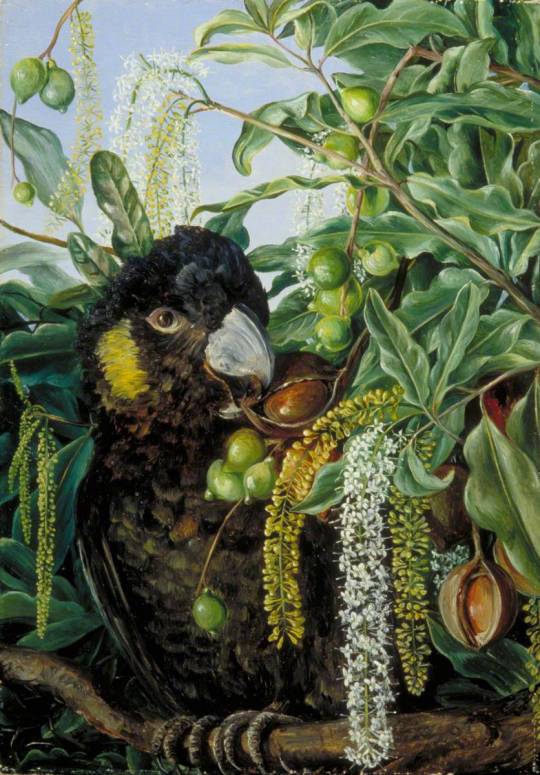
Marianne North (English, 1830-1890)
Foliage, Flowers and Fruit of a Queensland Tree, and Black Cockatoo c. 1880-1
painting, oil on board
H 50.9 x W 35.4 cm
Kew Gardens Marianne North Gallery [MN790]
PS - This bird is misidentified on the Kew Gardens website as a Red-tailed Black Cockatoo (Calyptorhynchus banksii), but it's actually a Yellow-tailed Black-Cockatoo (Zanda funerea) - the yellow cheek patch distinguishes it as the latter:
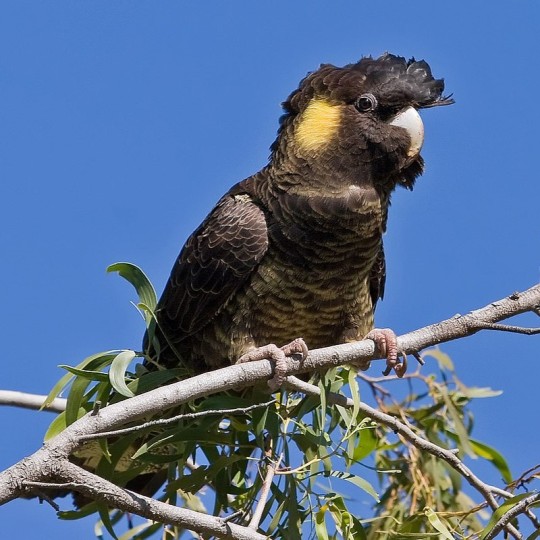
You can view all of Marianne North's paintings with animals in them here:
Bonus: Here's an actual Red-tailed Black Cockatoo (male) by Eileen Mayo, from her poster series made for the Australian National Travel Association in the 1950s. Fun wordplay here too - the bird's scientific name is Calyptorhynchus banksii and she placed it on a Banksia plant. :)

Eileen Mayo (1906-1994)
AUSTRALIA / COCKATOO & BANKSIA
c. 1955-7
poster, 39 3/4x25 inches, 101x63 1/2 cm.
Australian National Travel Association
#womenartists#hernaturalhistory#womeninscience#womeninhistsciart#Marianne North#Victorian art#English art#British art#bird#birds in art#parrot#cockatoo#Yellow-tailed Black Cockatoo#Macadamia#natural history art#scientific illustration#19th century art#European art#Australian art#Australian animals#Australian wildlife#painting#oil painting#Kew Gardens#Marianne North Gallery#International Womens Day#Womens History Month#Eileen Mayo#Banksia#Australian National Travel Association
10 notes
·
View notes
Photo

Orchid and Humming Birds, Brazil
Marianne North (1830–1890)
Marianne North Gallery
141 notes
·
View notes
Text

'Coming Out' of a Cape Beauty
Marianne North. (1830–1890)
Marianne North Gallery
37 notes
·
View notes
Text
Zadok Ben-David: Natural Reserve @Shirly Sherwood Gallery of Botanical Art, Kew Gardens (Museum/Gallery #9)

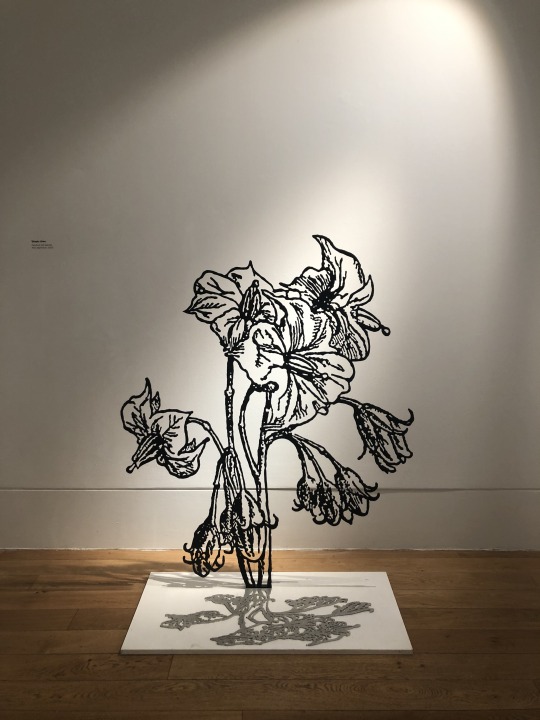
(日本語は英語の下にあります)
The other gallery we went to in the class in Kew Gardens is Shirly Sherwood Gallery, which stands right next to the Marianne North Gallery about which I wrote in the latest post. The special exhibition "Natural Reserve" by a London-based artist Zadok Ben-David was being held.
The main work of this special exhibition is an installation named Blackfield (photos below), which he puts in description as "an optimistic psychological installation presenting two extreme situations - life and death. ... a symbol of two extreme emotional states - happiness and grief."
As I walked around the room, the color of the nature - trees and flowers - changed from black to bright colors, according to which my emotion, or rather impression of the work, shifted. To be more concise, the work seemed quite dark and depressing at first, but as you see the vivid colors on the opposite side, the work was more happy art. Since the subject of the work is nature, it is easy to associate "death and life" with those two ways of seeing.
I believe that this work has its significant meaning by having these two "art" in one work. It would lose its meaning if there are two different trees, one of which is just black trees and the other is colorful nature. This shift of color / liveliness while walking around the installation is only experienced by actually visiting this gallery and putting yourself in this room.
Not only the Blackfield but also other works including the animation movie had a strong message about human activities and its influence on nature.
I loved two things about this exhibition: One is that it involves more "immersive experience" aspect of a gallery than normal galleries. And the other thing is that it addresses social problems strongly, which reminded me of how art can potentially convey huge messages.
(日本語)
キューガーデンでの授業で行ったもう1つのギャラリーというのがシャーリー・シャーウッド・ギャラリーという、前回の投稿のマリアンヌ・ノース・ギャラリーの真隣にある施設です。ロンドンを拠点に活動するザドク・ベン=ダヴィドさんの"Natural Reserve"という特別展が開催中でした。
この特別展の目玉作品はBlackfield (ブラックフィールド)というインスタレーションです。彼自身の言葉で「生と死という両極端の状況を表す心理的なインスタレーション(中略)幸せと悲しみという両極端な感情のシンボル」という風に説明されています。
展示室内を歩くと、自然(木や花)の色が黒からカラフルに変わっていきます。それに従って私の感情(というより作品の印象)が同時に移り変わります。もう少し具体的にいうと、はじめは黒一色の自然で始まるのでかなり暗くて鬱な雰囲気ですが、その裏まで回ると裏面は鮮やかな色が塗られているため、幸せな雰囲気になるのです。主題が自然だということもあって、この2つの印象が「生と死」に自然に繋がります。
この2つの側面が1つの作品の中にあるというのが、この作品の大切なポイントなのではないかと私は思います。もし黒だけの作品とカラフルなものだけの作品が1つずつあったとしてもこれほどの強い意味は持たないのかと。色や鮮やかさの移り変わりは、実際にこの部屋にきて歩かないと体験できないものです。
このBlackfieldだけではなくて、アニメーションの映像作品も含めて他の作品も、人間の活動と自然への影響についてのつよーいメッセージが感じ取れました。
この展覧会で私が好きな点は2つあります。1つは、他の展覧会と比べて「体験型」の展示だった点。(インスタレーションなのでそうなりやすいですが。)2つ目は、社会問題にかなり強くアプローチしている点。アートが大きなメッセージを伝える力を秘めているということに改めて気がつきました。


3 notes
·
View notes
Photo
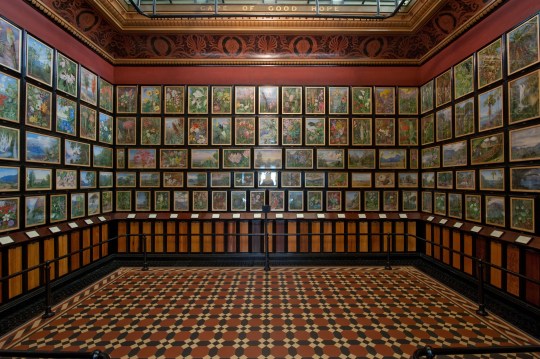
Marianne North (1830 – 1890)
Many botanical artists have had a huge impact on our current understanding of plants.
Marianne North was a remarkable plant hunter and botanical painter.
She challenged the tradition of Victorian flower painting and chose to paint plants in their natural settings instead. Her work became a powerful record of the dramatic landscapes she visited and the plants that inhabit them - years ahead of the invention of colour photography.
She created over 800 paintings of more than 900 species of plants during her solo travels across the world in the late 1800s.
These masterpieces now line the walls of the Marianne North gallery here at Kew.
38 notes
·
View notes
Photo

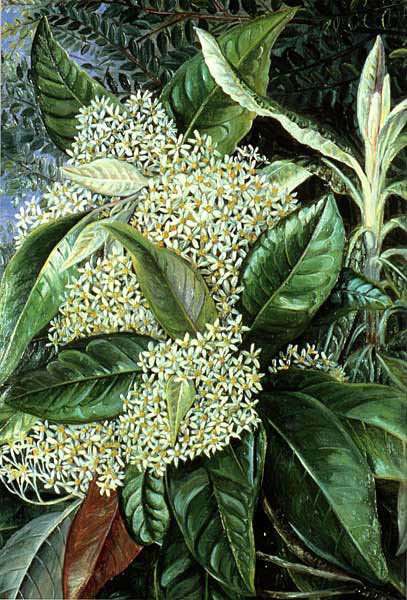
Marianne North (1830-1890) was a biologist and botanical artist, working in Victorian England. The North Gallery in Kew Gardens, London, is named after her, and is the only permanent solo exhibition by a female artist in Britain.
She travelled extensively and captured botanical subjects from all over the world in her paintings. These works were praised for their scientific accuracy and their ‘purity and brilliancy of colour’. The gallery that bears her name opened in 1882 and can still be visited today.
Above: Olearia argophylla
#born on this day#amazing women#marianne north#england#uk#art#women in art#biology#women in biology#botany#feminist#feminism
732 notes
·
View notes